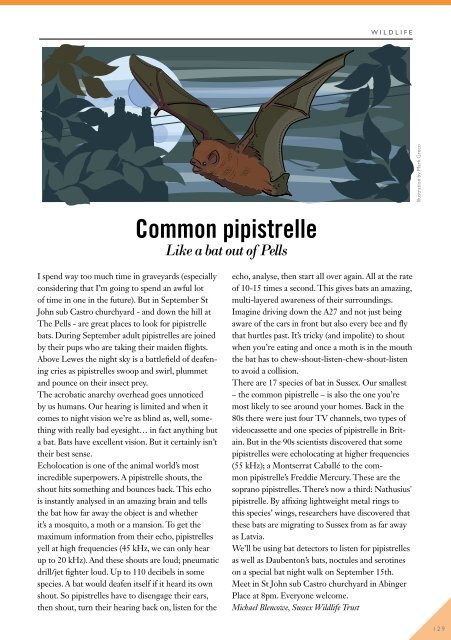You also want an ePaper? Increase the reach of your titles
YUMPU automatically turns print PDFs into web optimized ePapers that Google loves.
WILDLIFE<br />
Common pipistrelle<br />
Like a bat out of Pells<br />
Illustration by Mark Greco<br />
I spend way too much time in graveyards (especially<br />
considering that I’m going to spend an awful lot<br />
of time in one in the future). But in <strong>September</strong> St<br />
John sub Castro churchyard - and down the hill at<br />
The Pells - are great places to look for pipistrelle<br />
bats. During <strong>September</strong> adult pipistrelles are joined<br />
by their pups who are taking their maiden flights.<br />
Above <strong>Lewes</strong> the night sky is a battlefield of deafening<br />
cries as pipistrelles swoop and swirl, plummet<br />
and pounce on their insect prey.<br />
The acrobatic anarchy overhead goes unnoticed<br />
by us humans. Our hearing is limited and when it<br />
comes to night vision we’re as blind as, well, something<br />
with really bad eyesight… in fact anything but<br />
a bat. Bats have excellent vision. But it certainly isn’t<br />
their best sense.<br />
Echolocation is one of the animal world’s most<br />
incredible superpowers. A pipistrelle shouts, the<br />
shout hits something and bounces back. This echo<br />
is instantly analysed in an amazing brain and tells<br />
the bat how far away the object is and whether<br />
it’s a mosquito, a moth or a mansion. To get the<br />
maximum information from their echo, pipistrelles<br />
yell at high frequencies (45 kHz, we can only hear<br />
up to 20 kHz). And these shouts are loud; pneumatic<br />
drill/jet fighter loud. Up to 110 decibels in some<br />
species. A bat would deafen itself if it heard its own<br />
shout. So pipistrelles have to disengage their ears,<br />
then shout, turn their hearing back on, listen for the<br />
echo, analyse, then start all over again. All at the rate<br />
of 10-15 times a second. This gives bats an amazing,<br />
multi-layered awareness of their surroundings.<br />
Imagine driving down the A27 and not just being<br />
aware of the cars in front but also every bee and fly<br />
that hurtles past. It’s tricky (and impolite) to shout<br />
when you’re eating and once a moth is in the mouth<br />
the bat has to chew-shout-listen-chew-shout-listen<br />
to avoid a collision.<br />
There are 17 species of bat in Sussex. Our smallest<br />
– the common pipistrelle – is also the one you’re<br />
most likely to see around your homes. Back in the<br />
80s there were just four TV channels, two types of<br />
videocassette and one species of pipistrelle in Britain.<br />
But in the 90s scientists discovered that some<br />
pipistrelles were echolocating at higher frequencies<br />
(55 kHz); a Montserrat Caballé to the common<br />
pipistrelle’s Freddie Mercury. These are the<br />
soprano pipistrelles. There’s now a third: Nathusius'<br />
pipistrelle. By affixing lightweight metal rings to<br />
this species’ wings, researchers have discovered that<br />
these bats are migrating to Sussex from as far away<br />
as Latvia.<br />
We’ll be using bat detectors to listen for pipistrelles<br />
as well as Daubenton’s bats, noctules and serotines<br />
on a special bat night walk on <strong>September</strong> 15th.<br />
Meet in St John sub Castro churchyard in Abinger<br />
Place at 8pm. Everyone welcome.<br />
Michael Blencowe, Sussex Wildlife Trust<br />
129


















